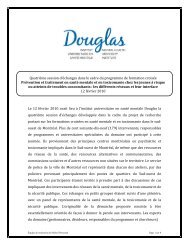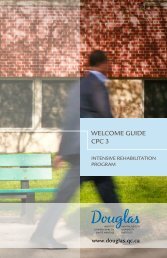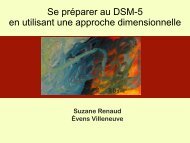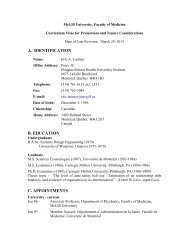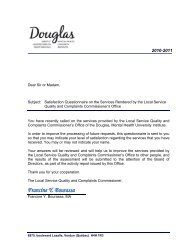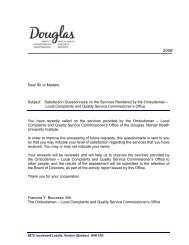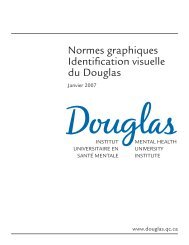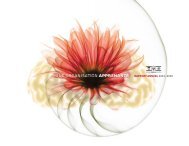Suicide Among Aboriginal People in Canada - Institut universitaire ...
Suicide Among Aboriginal People in Canada - Institut universitaire ...
Suicide Among Aboriginal People in Canada - Institut universitaire ...
You also want an ePaper? Increase the reach of your titles
YUMPU automatically turns print PDFs into web optimized ePapers that Google loves.
Chapter 2based on records from the local detachment of the Ontario Prov<strong>in</strong>cial Police, and Shkilnyk noted thatthis under-represents the number of suicide attempts, particularly <strong>in</strong> cases precipitated by sexual abusewhere the victims were especially reluctant to talk to police.A study of the Inuit on the East Coast of Hudson’s Bay, based on a review of the medical charts of alldeceased <strong>in</strong>dividuals from 1982 to 1996, yielded a rate of 55/100,000 ( Boothroyd et al., 2001). For1982 to 1986, the rate was 32.3/100,000, while for 1987 to 1991, it was 87.9/100,000. Most of this<strong>in</strong>crease was due to a cluster of 10 suicides <strong>in</strong> 1991. The unadjusted rate thus jumped from twice to morethan five times the national average. Fully 90 per cent of suicides occurred <strong>in</strong> the 15–25 year age group.If “possible” suicides are added to the suicide group, then the rate rises to 86/100,000 over 10 years(46 for 1982 to 1986 and 126 for 1987 to 1991); aga<strong>in</strong>, 83 per cent of suicides occurred among youth.S<strong>in</strong>ce 1991, the rate has cont<strong>in</strong>ued to rise (Boothroyd et al., 2001 [unpublished data]). From 1982 to1996, the rate of suicide among Inuit <strong>in</strong> northern Quebec rose five-fold and doubled aga<strong>in</strong> from 1996to 2001 (Kouri, 2003). Similar dramatic <strong>in</strong>creases have occurred among Inuit <strong>in</strong> Nunavut and Nunavik(though not <strong>in</strong> the Western Arctic), ris<strong>in</strong>g from about 63/100,000 <strong>in</strong> 1985 to 104/100,000 <strong>in</strong> 1995 and125/100,000 <strong>in</strong> 2003 (Hicks, forthcom<strong>in</strong>g, 2007; Turecki et al., 2006) (see Figures 2-10 and 2-11).The Prevalence of Suicidal Ideation and AttemptsSuicidal ideation and attempts are much more frequent than death by suicide and have a wide spectrumof severity. A study compar<strong>in</strong>g random samples of households <strong>in</strong> n<strong>in</strong>e different countries <strong>in</strong> the 1980sfound that the lifetime prevalence of suicide ideation was 16.5 per cent <strong>in</strong> the United States and 11.3 percent <strong>in</strong> <strong>Canada</strong>; while the prevalence of suicide attempts was 4.8 per cent and 3.8 per cent, respectively(Weissman et al., 1999). A meta-analysis of 128 published studies <strong>in</strong>volv<strong>in</strong>g over 500,000 adolescents(ages 12–20) worldwide found average rates of lifetime suicidal ideation of 29.9 per cent and suicideattempts of 9.7 per cent; the 12-month rates were 19.3 per cent for suicidal ideation and 6.4 per cent forsuicide attempts (Evans et al., 2005). A study <strong>in</strong> northern Nova Scotia found 12-month rates of suicidalideation of 16.6 per cent and suicide attempt of 5.1 per cent (Wang et al., 2003).In 2001, 19 per cent of youth <strong>in</strong> the United States reported seriously th<strong>in</strong>k<strong>in</strong>g of suicide, 8.8 per cent madea suicide attempt, and 2.6 per cent made a suicide attempt that required medical attention (Grunbaum et al.,2002). Rates among <strong>Aborig<strong>in</strong>al</strong> youth are much higher. The U.S. Adolescent Health Survey, adm<strong>in</strong>isteredto approximately 13,000 American Indian and Alaskan Native high school students liv<strong>in</strong>g <strong>in</strong> non-urbansett<strong>in</strong>gs, <strong>in</strong>dicated that 17 per cent had attempted suicide at some time (Blum et al., 1992). The NationalAmerican Indian Adolescent Health Survey conducted <strong>in</strong> 1990 <strong>in</strong>cluded 11,666 American Indian andAlaska Native youth attend<strong>in</strong>g grade 7 through 12 <strong>in</strong> schools on reservations serviced by the Indian HealthService throughout the United States. Overall, 21.8 per cent of girls and 11.8 per cent of boys reported oneor more suicide attempts (Borowsky et al., 1999). More recently, a survey of 1,638 people <strong>in</strong> two NorthernPla<strong>in</strong>s Indian reserve communities <strong>in</strong> the United States found a lifetime prevalence of suicide attempts of6.6 per cent among males and 10.7 per cent for females; 1.4 per cent of those 15–24 years of age had made asuicide attempt <strong>in</strong> the last year (LeMaster et al., 2004). The first study to exam<strong>in</strong>e rates of attempted suicide<strong>in</strong> Native Hawaiians surveyed 3,092 students <strong>in</strong> grades 9–12 and found that Native Hawaiians had asignificantly higher rate of suicide attempts (12.9%) compared to non-Natives (9.6%) (Yuen et al., 2000).Until recently, there has been little good data on the prevalence of suicide attempts among <strong>Aborig<strong>in</strong>al</strong>groups <strong>in</strong> <strong>Canada</strong> s<strong>in</strong>ce most studies are limited to people who are brought to medical attention and who20




